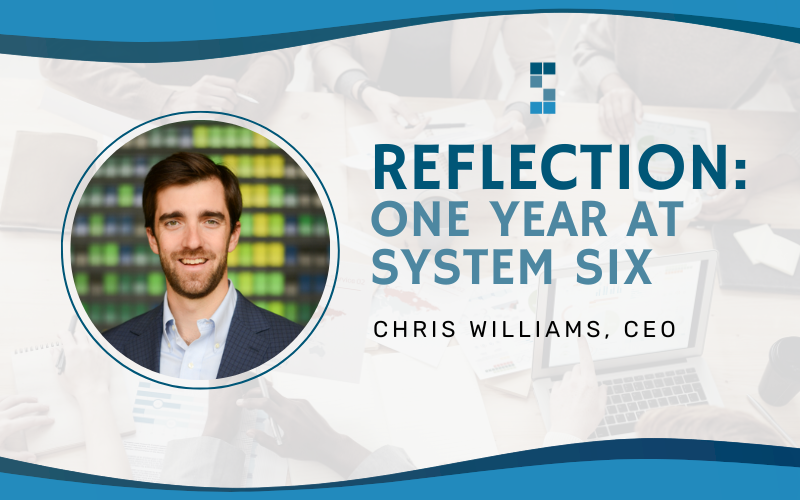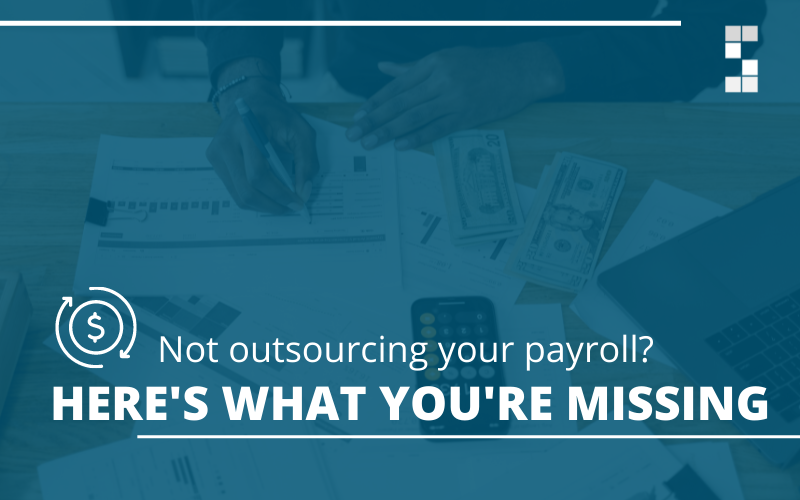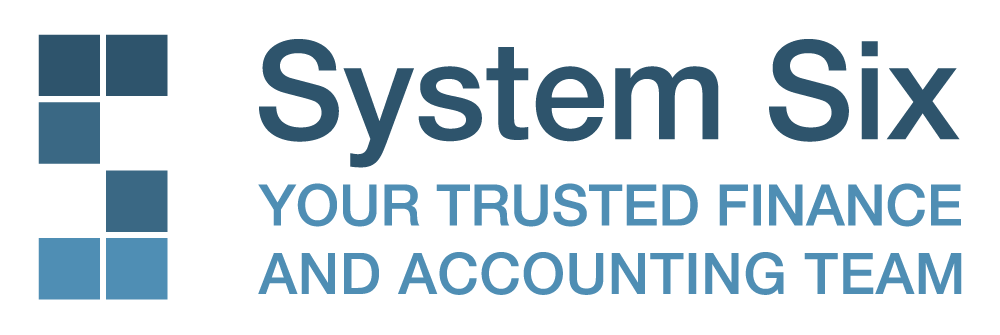
by Chris Williams | Sep 15, 2022 | Blog
Over Labor Day weekend, as a busy summer came to a close for System Six and for Blair and me personally, I was lucky to have some quiet time to sit back and reflect on my first year at System Six. I realized what an exciting, challenging at times, and certainly motivating year it’s been, and I thought I’d take some time to share some reflections on the year behind and all that’s ahead.
First and foremost, I’m thankful. Thankful to Jeremy, Joe, Kelly, Brooks, Lia, and the many people who built System Six over the past 13 years. They built a great business – one focused on bespoke, high-quality services using the right modern technology and processes. But more importantly, they focused its core, its ethos, on what matters most in our industry: People. They built a fantastic culture focused on joy and flexibility where the team delivers excellence, but also has fun along the way. So thank you for what you’ve built and for giving me the chance to usher System Six forward to the next level – one where we’ll continue to focus critically on making System Six the best place to work in cloud accounting.
I’m also thankful to our current team for welcoming me with an open attitude – especially to Brooks and Kelly, whom I worked with most closely out of the gate. They let me ask lots of questions and patiently listened to some not so great ideas. They let me accelerate our pace of growth, ran towards new tasks I asked of them, and allowed me to make changes to many well-established processes (meeting cadences, pay periods, hiring processes, etc.)
And to the broader team at System Six. Thank you. You, too, welcomed me with open arms, gave me a chance, and were quick to share ideas you had for improvement. Importantly, you continued to serve our clients with excellence and carried forward the most important part of System Six – our culture. I’m so thankful to work with and serve such a fantastic team. Keep it up!
And finally, I’d like to thank the broader Cloud Accounting community. Through conferences, early days coffee chats, leadership retreats, etc., many other leaders and vendors have welcomed me into the space. I’m thankful for the friendships built and the knowledge you’ve shared as we all scale our businesses alongside each other.
Next, I’m excited. Our near-term goals coming into System Six were first to honor the current business, team and core values, but next to start the journey to improve and scale our organization from one of ~20 people to one much larger, serving dozens and dozens more team members and hundreds and hundreds more clients. Thirteen months in, we’re well on our way. Of course, making fast progress towards our goals fires me up!
In a year of change, we’ve added 12 new team members and grown revenue by nearly 30%, serving over 40 new organizations from startups to scaled organizations to non-profits. There are lots of metrics we look at to monitor our business, but the one we’re most proud of is that over 90% of our job offers have been accepted. Candidates experience our culture during our extended interview process, and by the end of it, they want to come on board! This is our special sauce – our awesome team, and the fantastic culture they nurture.
Certainly, to accomplish all this, we’ve invested more across many aspects of our business, especially in hiring and new systems and processes internally, but we’re happy to remain healthily profitable. And of course, we’ve made mistakes along the way – internally and with clients – we are human. But all in, the last 13 months have been a great start to our vision for scaling System Six. And all of it is thanks to our great team.
Second, I’m excited for that very team! With growth comes opportunity – we’ve promoted several awesome individuals, given others expanded work or responsibility in their current seats, and bolstered our leadership capacity. We’re thrilled to have elevated Jaime to a Process Improvement Lead and Kelly to Head of People, a role she was already leading in many ways. As we continue to grow, I know our team will have more compelling opportunities, and I am excited to see who will step up and continue to advance their careers!
Finally, I’m motivated. Motivated to do better, both as a business, but also personally as a leader. A lot has gone right in the last 13 months. And I’m super thankful for that – we’ve worked hard, and our team has excelled. But, as we talk about internally, There’s Always Better! I’ve made some real mistakes this year – hiring too quickly, taking on complicated client projects without properly quoting costs, etc. And there are certain strategic goals we just won’t get to this year. We’ve learned a ton from these lessons, and already made improvements, but I know There’s Always Better – I can do more to deliver better outcomes for our clients and, most importantly, our team. And that’s motivating.
As I mentioned above, there’s so much demand for the services we provide. And that means there’s a clear chance to grow our team and deliver our workplace experience to more and more happy accountants. That dual-sided mission – to serve both clients and team – at an ever-increasing scale, inspires me to do better, even if just 1% better every day (shoutout to James Clear!) Over many years, if not decades, that can amount to something pretty impressive!
What an awesome year. It started with a smooth transition, largely thanks to the team that came before me and the current System Six team, who so graciously welcomed me and gave me a chance to learn. From there, both customers and team grew, validating our assumptions about the opportunities ahead of us. And we learned a ton, including from mistakes, and we can’t wait to bring those lessons to year two!
In the coming year, we’ll continue to hire and bring on new customers. But we’ll also implement new technology, add to our leadership team, and further systematize operations to support our growth – so that we can best serve our customers and our team. And we’ll never lose sight of our Northstar – building the best place to work in cloud accounting.
Onwards!

by Chris Williams | Sep 12, 2022 | Blog, Leadership
Annual Retreat for Our Remote Team
In late July, over 30 System Six team members and their partners gathered in Denver for several days of good old fun together! We all arrived on Friday at the beautiful Omni Interlocken Hotel, where the team spent the weekend enjoying the many wonderful things the resort had to offer – a great gym, a fun bar with pool tables, a driving range, great food and drinks, and of course, a ton of sun by the pool!
Friday night, we kicked off the weekend with dinner at Centro in Boulder – margaritas at dinner and to-go churros for our ride back to the hotel were especially big hits! Saturday, the team split up and went hiking, white water rafting, and museum exploring before reconvening for lunch. Several team members said they’ve now conquered their white water rafting fear and are looking forward to more challenging rapids next time! For lunch, we enjoyed cider, pretzels, and at the vista at Acreage by Stem Ciders. We finished just in time before the afternoon thunderstorms arrived.
We ended our weekend together on a high note – dinner at one of Denver’s hottest spots, the Happy Camper! Situated right in the middle of the restaurant, we cheered along as several adjacent groups celebrated birthdays, bachelorette’s and all kinds of joyful events!
While we packed in a lot of activity, we also were so thankful we had the chance to spend so much time together!
Being the Best Place to Work in Cloud Accounting
At System Six, our North Star is simple – to build the best place to work in Cloud Accounting. While we recognize we’ll never fully arrive at that goal, we are committed to always doing better. Our annual team gathering once a year is a joyful perk of working at System Six and provides us time to explore a new city, savor wonderful meals, and enjoy fun activities.
But, while we enjoy the time for it’s pure fun, our summer outings are even more powerful because of the connections we build with each-other. Especially in a remote environment, we know it takes time to get to know our peers and our managers, breaking the ice on Zoom meetings will never feel 100% natural; in person time is essential.
This is why our summer gatherings are so important, and why they’ll continue to be a priority of ours as we keep growing – we’ll just need more space next year! Of course our whole team can’t always attend, but we relish the opportunity to get to know one another, share some laughs (or screams on the river!), and to get perhaps just a bit too competitive at the pool table.
These small, unscheduled moments help us deepen our relationships, allowing us to better support each-other at work, solve problems faster, and appreciate one another more. It means virtual meetings feel a bit more natural when we truly know the person on the other side. All of these outcomes, we hope, make the day-to-day at System Six a bit more fun, joyful, and productive. Ultimately, we are building the best place to work in Cloud Accounting!
Many thanks to our team for making the trip this summer.We can’t wait to see you again next summer – in a location soon to be announced!

by Chris Williams | Jun 21, 2022 | Bookkeeping Best Practices, Non-Profit
It’s generally assumed that nonprofit businesses with a 501(c)(3) status, (particularly churches,) don’t have to pay taxes on – well, anything. While that is mostly true, there are definitely exceptions to the rule. Not fully understanding those exceptions could cost your nonprofit organization money and, in extreme cases, your organization’s 501(c)(3) status.
If you do the bookkeeping for or manage a nonprofit, it’s important to remember that your charitable status does not give you a license to never be taxed on any of the money you bring in. As a nonprofit entity, it is crucial for you to understand the nuances of taxable vs. nontaxable income.
Let’s talk about what it looks like to maintain a charitable status and what situations your nonprofit might face where funds received need to be classified and reported as profit.
Maintaining Charitable Status
First, to be deemed a nonprofit an organization must file for and receive 501(c)(3) status from the IRS. A non-profit also needs to obtain a state business license. Rules can vary from state to state, but generally, your state business license will need a renewal occasionally. The 501(c)(3) status does not need to be renewed but can be revoked by the IRS if they determine it is being exploited for profit.
Every nonprofit organization must file a Form 990 each year. While this form isn’t reporting taxable income, it does report your organization’s income and expenditures to the IRS each year. This transparency with the IRS is as much for your organization’s protection as it is for the IRS’s. As we’ll see ahead, there are many “gray” areas nonprofits can find themselves in where the line between donations and for-profit transactions can get blurry. The 990 form helps a non-profit prove that it is following the rules and not abusing its charitable status.
What qualifies as non-profit taxable income?
The most basic way to determine whether or not your nonprofit’s income is taxable or not is to consider if it’s actually a freewill donation or if it is a transaction of goods for money. Anything not purely a donation needs to be taxed as profit.
Let’s look at some situations an organization might find itself in where these questions might arise:
It is not uncommon for large churches to have a coffee shop, bookstore, or thrift shop under their organization’s umbrella. Even if the profits from these stores go directly to fund the church’s charitable work, they still need to be taxed the same as any independent coffee shop or bookstore would be.
In a coffee shop, gift shop, or thrift store, customers exchange money for a product sold for a specific price. Ultimately, this is a for-profit business functioning within a non-profit.
The same policy applies to the exchange of services for money. Let’s say a church runs a daycare center out of its facility. If parents and guardians are paying the church for the service of caring for their children, this is an exchange of services for profit. Even if a church is renting space out to another non-profit organization or renting out its resources, (like a parking lot), that rent income still needs to be reported as profit.
Reporting Taxable Income as a Nonprofit
If your nonprofit organization engages in transactions like the ones mentioned above and is receiving any income that doesn’t qualify as purely donation, it will need to take extra steps to ensure that income is accounted for properly.
The 990T (990 Taxable) form is specifically for nonprofits to report any income that needs to be taxed as profit. This is a separate form than the 990, which every nonprofit needs to file, and does not account for taxable income.
Situations that Fall Under “Donations” and Do Not Need to be Taxed
What about more nuanced situations like fundraisers, you might ask? What organization doesn’t occasionally host a raffle, a “spaghetti dinner,” or a bake sale to raise money for a charitable cause or mission?
As long as the money raised goes directly to the advertised cause, an organization can have a “suggested donation amount” or “pay what you can” policy that keeps it under the “donation” bracket, thus avoiding taxes. In this instance, there isn’t a consistent revenue stream being built under a non-profit umbrella; it is a one-off event.
Similarly nuanced are situations where an organization is refunded for products/services. Perhaps a youth group wants to have t-shirts with their group’s logo, or a small group wants to host a catered dinner event. An organization can ask participants to pitch in a set amount of money to cover those costs, and because it is a one-time, low-volume transaction with direct ties to a net-zero profit, it does not need to go under the “profit” bracket.
Consequences of not following the rules:
Conceivably, if your organization has 501(c)(3) status and the IRS determines that you are not properly following their rules, they retain the right to revoke your charitable status.
Unfortunately it is totally feasible and possible for an organization to start a fraudulent non-profit simply to get around income and property taxes. The IRS is fully aware of that, which is why the 990 and 990T forms are necessary to keep transparency and accountability between a non-profit and the government.
In the same vein, it is also possible for a nonprofit with good intentions to appear to the IRS as if it has been acting fraudulently, simply by not understanding and distinguishing correctly between what income falls under “donations” and what income falls under “profit.”
If you are a bookkeeper for a nonprofit, it’s important to tread wisely as you make these distinctions. Your charitable status and your organization’s reputation hang on it!
At System Six, we want you to know that you don’t have to do this work alone. We have years of experience helping churches and nonprofits manage their bookkeeping, and we also can make referrals to vetted, experienced nonprofit-specialty CPAs as resources for 501(c)(3) companies.
Want to learn more? Contact us today!

by Chris Williams | May 25, 2022 | Blog, Bookkeeping Best Practices, Leadership
Modern payroll is complex, covering everything from taxes to benefits to managing a variety of employees and contractors. As your remote finance team, we employ a robust tech-stack of cloud-accounting tools to streamline these exact payroll processes for you. These tools not only allow us to manage consistent, trustworthy compensation for your employees, but also provide best-in-class reporting capabilities and integrations with your accounting software.
But many may still be wondering, is outsourcing payroll really worth the investment?
If you’re a small business owner with only a few employees or have a history of managing payroll on your own, you’re probably hesitant to outsource this responsibility. Read on to see three ways that outsourced payroll provides value far beyond simply compensation management.
The Tax Arena
Paying employees properly is far more complicated than simply managing time, wages, and cash flow; you need to account for all of the complex tax details.
Outsourcing payroll includes offloading the coordination and liability of properly setting up and filing employees’ tax paperwork. System Six uses payroll specific tools like Gusto because, should a mistake or discrepancy arise in the tax filing process, Gusto takes on the responsibility of paying any fines and penalties associated with late or incorrectly filed returns.
With remote work growing in popularity and normalcy, registering employees for taxes isn’t simple. Small and big businesses alike employ remote workers across multiple states, cities, and municipalities. While this opens doors to valuable possibilities, it also creates new hassles in the onboarding process. In addition to differing tax codes, states have inconsistent implementations and descriptions of their rules and regulations. This can lead to confusion, mistakes, and possible penalties as you onboard employees.
When you outsource payroll, we ensure your employees are paid on time, but also partner with another firm, CorpNet, who assists with registering for tax accounts in states when you expand or hire in new areas of the country. CorpNet will communicate with each state on your behalf, ensuring that each state’s tax accounts are properly set up, submitting essential paperwork on your behalf.
Benefits Management
The second value-add of outsourced payroll tools is assistance with benefits management. A high priority for today’s workforce is the availability of benefits, including paid time off, insurance, and 401ks, just to name a few.
Just like tax registration can vary from state to state, benefit requirements vary also. For instance, certain states now mandate that all employees be provided paid time off, regardless of whether they are part-time or full-time. With remote work on the rise, employers may find employees working from states with varying PTO requirements.
Some outsourced payroll platforms have the capability of accounting for each state’s PTO requirements and codes. They can then track and manage PTO hours for employees, which is a huge time saver for business owners.
This is where we love using a tool like Gusto with our clients. Gusto offers both benefits packages through its own network of brokers and more recently added the ability to “bring your own broker.” This new feature allows its clients to reap the rewards of running benefits directly through the Gusto software while always maintaining a relationship with the broker of their choice.
While we’re singing Gusto’s praises, we need to mention a unique feature they now offer, the “Gusto Wallet” app. For the company with employees who occasionally request or find they need an advance on their paycheck, Gusto Wallet can be a lifesaver for employers and employees alike. Personally taking responsibility for and tracking advancements on payroll is risky and never advisable for business owners. With the Gusto Wallet app, however, employees can set aside monthly money from their checks that allow them to access emergency cash in between paychecks if the unexpected happens. Providing practical ways of making financial health a reality for employees is a huge benefit.
HR Tools & Support
The final added benefit is more robust HR tools. From advertising and managing job postings to job offers and onboarding to assisting with performance reviews, payroll platforms offer a lot of tools to help the modern business owner with HR responsibilities. For example, Gusto’s job postings integrate with popular job boards and their onboarding allows new employees to electronically sign custom documents, such as handbooks.
Some of these tools are newer to Gusto’s suite, and they can be a huge asset for businesses that need help getting off the ground and don’t have the necessary staff to take on all the HR functions themselves.
As a part of holistic client accounting services, we recognize the immense overlap between managing payroll and other elements of a healthy human resources department. Streamlining employee compensation goes hand in hand with caring for and supporting your employees. In simpler times, payroll was just a check every other Friday, but now payroll is intertwined with many facets of being an employer. Outsourcing this component of financial management is an incredible benefit to business owners; it allows them to focus on the business and not get lost in the financial complexities of PTO, benefits, family medical leave, and more.
Outsourced Payroll is for Everyone
These days it really doesn’t matter whether you’re a brand new start-up with just one employee or an established, multi-million dollar business – outsourcing payroll to a trusted partner is a great option for everyone. Simply put, the time, unnecessary costs, and headaches outsourcing saves employers are worth the costs.
So let’s talk – we are here to help companies set up and manage payroll as a part of our outsourced bookkeeping and accounting services. Whether you need to streamline your payroll processes, onboard employees across a range of states, or just need to get started with payroll, now is the time to integrate a fully tech-enabled set of financial systems to manage your business with efficiency and accuracy. And that will ultimately free you up to focus your time and energy on other priorities, like running their business, investing in their passions, or spending valuable time with family!

by Chris Williams | Mar 23, 2022 | Blog, Leadership
“Once upon a time, there were three little pigs…”
You probably remember this well-known and oft-repeated story from childhood storybooks and cartoons.
The three pigs each have a vision and mission – to build a house; a house resilient enough to weather the notorious big bad wolf’s destructive huffing and puffing. But while each pig has the same vision and mission, they each go about executing it in very different ways, which ultimately leads to very different outcomes.
It was Thomas Edison who once said, “Vision without execution is merely hallucination.”
It’s not enough to just have a clear vision and mission – you have to execute that vision successfully and to do that well, you need the right building blocks and tools.
If smart processes act as the bricks in resilient execution, then strategic, consistent rhythms are the mortar that holds those bricks together. Rhythms are the framework for getting the most value and efficiency out of your team’s processes.
Tools for Traction
Gino Wickman, author of the books “Traction” and “Get a Grip,” created EOS (Entrepreneurial Operating System,) which has become a popular tool to help businesses implement successful rhythms to keep their team cohesive, consistent and efficient. These rhythms “synchronize how people in an organization meet, solve problems, plan, prioritize, follow processes, communicate, measure, structure, clarify roles, lead, and manage.”
Utilizing an operating system of rhythms for your business promotes a culture of clear communication, discipline, and accountability. These values are integral to making your processes work effectively for your team.
While there are numerous areas in which a company could implement systemized rhythms, there are three areas in particular where successful rhythms really maximize the value of the processes most companies employ. These three areas are: meetings, measurement, and accountability.
Meeting Rhythms
Regular meetings within an organization are imperative in maintaining healthy and effective communication across teams and equally important for strengthening interpersonal relationships among team members.
While that might sound like just plain common sense, it is surprisingly easy to lose traction in communication and working relationships when rhythms aren’t in place to ensure meetings are consistent and intentional.
This is becoming increasingly true in a work culture in which remote employees are growing in number and co-workers on the same team can stretch across time zones and continents. Being intentional about regular rhythms of meetings is more important than ever.
Measurement Rhythms
You need rhythms to track various metrics and measurables within your organization to understand if you are accomplishing your goals and values.
Gino Wickman introduced the idea of the Scorecard Method in his book, “Traction.” Leadership must identify a set of measurements that can accurately indicate the health of your business. The correct metrics will be specific to you, but they usually include things like accounts receivable, customer survey results, cash on hand, and market penetration.
It’s essential to have realistic goals for these metrics and set a regular rhythm to measure and discuss them. They may also need periodic readjustment as your understanding of your business, customers, and goals shift over time.
Accountability Rhythms
There can be no real growth without accountability. Rhythms of accountability keep you on track to staying true to your company’s values as well as to your company’s goals.
Implementing tools like EOS’s scorecards keep employees accountable to the goals they have committed to, which leads to increased momentum and traction company-wide. Be cautious of two or more people sharing a responsibility; there’s a good chance that no one will end up with accountability.
Having processes and rhythms in place that allow your team members to give honest feedback is critical to maintaining a great work culture. They also help communicate clearly across teams which team members are accountable for specific tasks. A culture of healthy accountability is vital to fostering a great workplace culture.
A Strong Foundation Leads to a Resilient Future
The three little pigs each had a mission to build a resilient house, but in the end, only one pig’s house was strong enough to withstand the big bad wolf’s schemes. It was the house with a strong foundation, carefully laid with bricks and mortar, that proved the most resilient of all.
When it comes to building a resilient business, you need strong building blocks to lay a strong foundation. Those blocks are ultimately strategy, people, and execution. When you’ve got a solid mission and vision, the right people in place, and successful rhythms of scalable processes to execute your goals, your company is going to be strong enough to withstand any disruptions, adversity, and curveballs that come your way.













